Table of Contents[Hide][Show]
A nourishing homemade baby formula using safe, whole ingredients. This recipe was developed and tested by Dr. Mary Enig, a PhD Nutritionist and originally published in Nourishing Traditions cookbook in 1996. It was formulated to match breastmilk as closely as possible and is also suitable for infants. Source: Weston A. Price Foundation
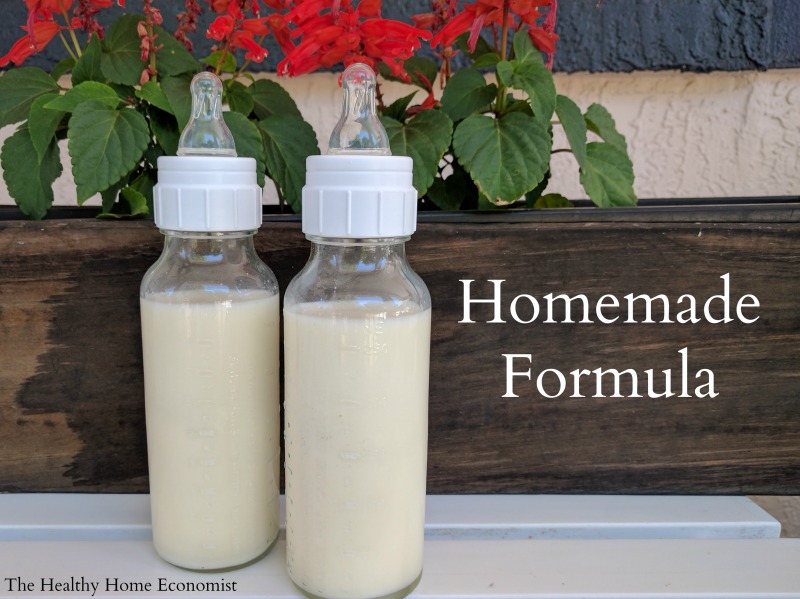
There is no doubt that breastfeeding your baby is the best option for the child’s long-term health and development. Human breastmilk from a well-nourished mother is the perfect food for baby. However, in circumstances where the child is adopted or the Mother finds herself unable to breastfeed, formula feeding becomes necessary. In those cases, homemade baby formula is best.
Using a baby formula recipe that closely matches the nutritional profile of breastmilk is a far better choice than even organic baby formula from the health food store. More on this below.
Note: Donor programs are widely available for human breastmilk. But, the diets of the donor mothers are unknown and most likely nutritionally insufficient. In addition, breastmilk banks pasteurize the donated breastmilk which destroys much of the nutritional benefit. Unless you are fortunate to have a trusted and direct donor milk source in your community, avoid this option!
Dangers of Commercial Formula
Commercial formulas are always a poor choice for a number of reasons. First of all, formula manufacturers line the cans with the chemical BPA. This substance disrupts hormone development and is a probable contributor to early puberty in girls, and ADHD, urogenital abnormalities, and other ills in boys.
The European Food Safety Authority found that canned commercial formula is a significant source of BPA for infants, exposing the child to 13mcg of BPA per kg of body weight per day! BPA-free formula cans are no better. The chemical BPS is typically used instead which is just as dangerous.
Beware that manufacturers pack even organic commercial formula like Earth’s Best in BPA cans. Worse, they use organic brown rice syrup as the primary sweetener which is known to be frequently contaminated with arsenic.
In addition, all commercial milk formulas are processed at extremely high temperatures which violently denature the fragile milk proteins, render them allergenic, and add carcinogens to the final product. Soy infant formula is the worst. Obscenely high processing temperatures not only denature the proteins but large levels of phytic acid in soy block mineral absorption by the infant. Moreover, soy-based plant estrogens disrupt the hormonal development of the baby!
It seems that for the concerned Mother who is unable to breastfeed, learning how to make baby formula at home with safe, pure ingredients is the most prudent way to go!
Why Make Homemade Formula Even if You Are Breastfeeding
In the video below, I show you how to make your own safe, healthy raw milk homemade formula for your baby.
The recipe I follow was originally published in the cookbook Nourishing Traditions in 1996 and developed by Dr. Mary Enig.
Even though I breastfed each of my children for at least 2 years, I made this exact formula for my own children when I was away for the day or the evening as pumping was not an option that worked well for me.
I even used this homemade formula for an entire day once when I had some dental work done and was advised to pump and discard for 24 hours.
As a result, even successfully breastfeeding Moms can use this wonderful homemade formula as a supplement when necessary to their own nutrient-dense breastmilk!
It is advised that even breastfeeding Mothers have the ingredients for this formula on hand for an emergency. If Mom is sick or otherwise unable to nurse, Dad can step in and make this safe alternative until Mom is back on her feet. It takes a few days to a week to gather all the ingredients together to make this formula, which is why I advise having them on hand at all times.
Homemade Most Nutritious
The image below lists the reasons why it is worth it nutritionally to make formula yourself for your precious baby!
You can order all of the required ingredients for the homemade baby formula in one package from this reputable, vetted source.
Moms who have successfully used this formula feeding your children, please post about your experience in the comments section to encourage those who are considering it and need some Mom to Mom encouragement!
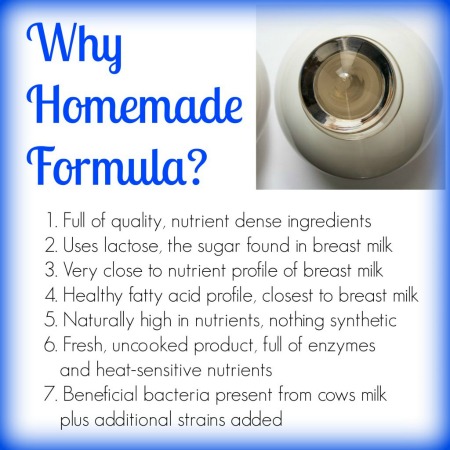
Where to Source Quality Milk
The most widely available grass-fed milk around the world is from cows. This is usually the most budget-friendly and easily sourced milk for this recipe for homemade formula.
If only goat milk is available in your area, this recipe for goat milk baby formula can be used instead. When using milk from ewes, please refer to the linked article for an adjusted recipe; one of the benefits of sheep milk is that it is higher in healthy fats than either goat or cow milk.
Camel milk formula is another option that is a particularly digestible form of dairy and growing in popularity around the world.
Alternatively, you can use low temp (vat) pasteurized, non-homogenized whole milk cultured with a piima or kefir starter. Then substitute the piima milk or kefir for the raw milk portion of the formula recipe. Cold-pressed raw milk also must be cultured before using it as it contains no probiotics.
Do NOT use ultrapasteurized (UHT) milk even if organic as it is too highly processed and extremely allergenic!
It is also best to avoid all types of powdered milk for this recipe. The factory process of making milk powder reduces nutrition considerably and denatures it, which makes it more likely baby will have an allergic reaction.
Dairy Allergy Option
If all types of dairy prove unsuitable for your baby, make this nondairy baby formula recipe instead. It uses a base of homemade bone broth as a substitute for milk. It is important not to utilize a plant-based or otherwise vegan baby formula recipe.
Avoid buying bone broth to make the dairy-free formula. Make it yourself! Manufacturers of commercial bone broth, even if authentic, may water down the end product. This is apparent if it does not gel when chilled in the refrigerator.
Many brands have toxic packaging issues as well. If you must buy it in a pinch, see my shopping guide page for vetted brands that are safe.
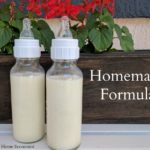
Homemade Baby Formula Recipe (for infants too)
A nourishing baby formula recipe you can make at home with safe, whole ingredients developed and tested by a PhD nutritionist to match breastmilk as closely as possible. Also suitable for infants.
Ingredients
- 2 cups raw cow milk OR organic whole milk yogurt
- 1 7/8 cups filtered water
- 1/4 cup liquid whey
- 4 Tbl lactose
- 1/4 tsp Bifidobacterium infantis powder
- 2-4 Tbl raw or pasteurized cream
- 1/2 tsp cod liver oil unflavored
- 1/4 tsp butter oil unflavored
- 1 tsp sunflower oil preferably organic
- 1 tsp extra virgin olive oil preferably organic
- 2 tsp virgin coconut oil preferably organic
- 2 tsp nutritional yeast
- 2 tsp gelatin
- 1/4 tsp acerola powder
Instructions
-
Fill a 2 cup Pyrex measuring cup with filtered water and remove 2 TBL (this will give you 1 7/8 cup water).
-
Pour about half the water into a pan and turn burner on medium.
-
Add the gelatin and lactose and let dissolve, stirring occasionally.
-
When gelatin and lactose are dissolved, remove pan from heat and add the rest of the water to cool.
-
Stir in the coconut oil and butter oil until melted.
-
Put remaining ingredients in a glass blender.
-
Add the water mixture and blend for about 3 seconds.
-
Place formula in glass baby bottles or a glass jar and refrigerate.
-
Before giving to baby, warm glass bottle in a pan of hot water or a bottle warmer. NEVER microwave baby bottles!
Recipe Video
Recipe Notes
If using raw cow milk from holstein cows, use 4 Tbl of extra cream (otherwise use 2 Tbl extra cream).
If choosing to make this homemade formula with camel milk, be sure to include 4 Tbl extra cream as camel milk is lower in cream than cow milk.
Do not use high oleic sunflower oil. Use only the brand recommended in the ingredients list which is cold pressed, organic, unrefined, and low oleic.
*Do NOT use powdered whey from the store as it is denatured. Avoid whey from making cheese as it will curdle the formula.
*Do not substitute pasteurized or powdered milk as these are heavily processed, denatured and allergenic foods.
*Do NOT use ultrapasteurized (UHT) cream. It is highly allergenic. Raw or pasteurized cream is acceptable.
*Do NOT use fish oil or krill oil instead of high vitamin cod liver oil as they do not contain any Vitamin D and very little to no Vitamin A.
Collagen powder may be substituted for the gelatin in a pinch (more on peptides in baby formula in this article).
If you are wondering where is the iron in homemade baby formula, this article provides an explanation.
If baby experiences constipation using this formula, try adding 1 tsp of molasses to each batch. This should help move things along.
How to Transition to DIY Formula
Once you’ve viewed the video, gathered the ingredients, and made your first batch, how do you feed it to your baby for the first time?
It is important not to switch all at once as this can cause gas, excessive spit-up, or an uncomfortable change in diaper habits such as constipation or overly loose stools.
Start by giving your baby three-quarters of the old formula blended with one-quarter of the homemade. Try this ratio for a day or two and see how your infant responds.
If no digestive upset or major change in diaper habits occurs, increase the amount to a 50-50 blend of old formula to homemade. Observe for another day or two as before.
If no major issues, increase once again to three-quarters homemade formula to one-quarter old formula. If baby does well on this blend for a third time, you are ready to fully transition to the homemade formula.
At any time during the transition, symptoms of intolerance emerge, back up to the previous successful blend ratio and stay there for a day or two before attempting to increase once again.
Homemade Formula FAQ
Weston Price Foundation
Feeding an Adopted Baby
Traveling Tips with Baby Formula Made at Home
Iron in Baby Formula
Collagen Peptides instead of Gelatin for Homemade Formula?


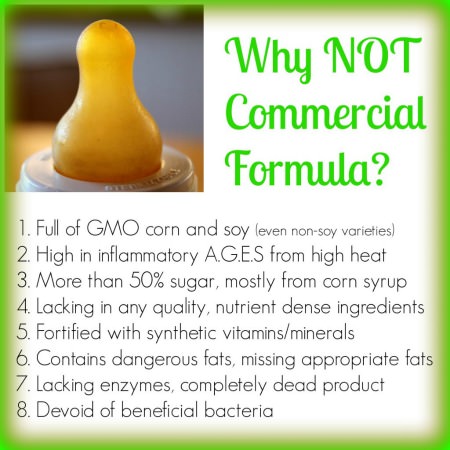
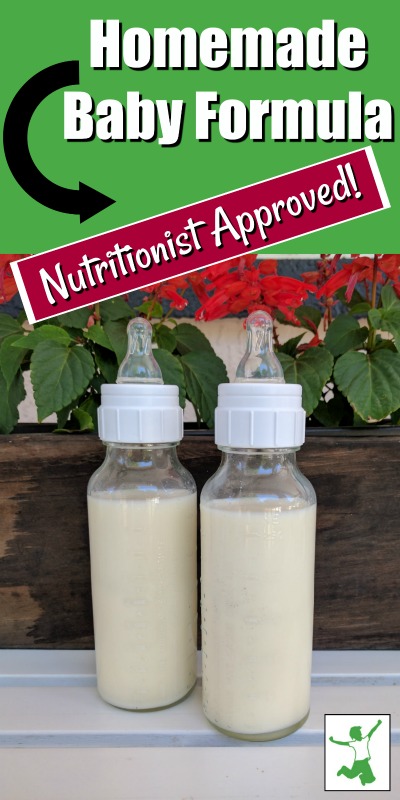






I made one batch that was fine, but the second one like “set up” in the fridge, and is now the consistency of runny yogurt. What did I do wrong????
I’m having the same problem, every time I make it it turns in overnite to runny yogurt. Please someone respond if this is ok to give to my infant.
I’m having the same problem. I think it’s the whey curdling the milk but I can’t find any info on it. Now that its fall it is not 72 degrees in my house and my whey is really cloudy. I feel like it must be the milk solids still in the whey that’s causing the trouble. Someone please help! How can I seperate my milk when it’s not warm in my home?
That also happens here. Just shake the bottle a bit. No worries.
mine is more set up than that. it’s the gelatin.
We receive fresh raw milk every other week. I freeze the second week’s supply and thaw it as needed. Can the thawed milk be used to make baby formula? Also, I read on your website that freezing milk 2 weeks makes it safer. Would it be beneficial to freeze all the milk we receive for two weeks?
i don’t know about making it safer, but i know it’s ok to freeze milk if you need to. it kind of puts the living stuff in the milk to sleep, but it awakes as it thaws.
I just started the homemade formula it has been 3 day and my son has not gone number two he was on store bought formula for one month pryor to me finding the healthier way is this normal and how many days is too many days with going potty?
is he having lots of wet diapers? if so, he isn’t dehydrated. my son only goes every few days sometimes, but he has plenty of wet diapers and his stool is not hard and dry, it’s wet and loose. that’s just how he is. i’ve verified it with doctors. it is not necessarily normal to poop several times a day for a baby.
As I am always researching this I have come back to this post and these comments several times. Just wanted to update and say that before the formula, while on commercial formula, baby poop was really watery and a weird green blue brown really dark color with a yeasty smell. There was a weird transition for a few days where it was half green and half yellow. But since then it is yellow and pasty and he goes more often, at least every two days, sometimes every day. I feel like this is more normal and closer to breastfed stools, except that there is an odor from eating foods besides breastmilk. It took a little bit of time for this to happen and the transition to be made. Just wanted to add this in case of anyone out there reading every little thing you can find on this formula like I was (still am).
Can I use homemade gelatinous chicken broth instead gelatin in the baby formula (milk based)??
I use homemade bone broth (gelatinous) instead of gelatin in my homemade formula for months now. It is impossible to find the recommended brand here (Europe) and I do not trust a bit in the only one I managed to find (NOW) as it is GMO (I sent them an email and they answered with some data about this). No GMOs here! I am very pleased with the result, my baby loves it.
I’m giving my baby the WAP milk-based formula for 3, maybe 4 weeks now. The first day I gave her the WAP formula she didn’t spit nor even once and that was amazing as she used to spit lots and lots of commercial milk I had to give her. The colic issue was also gone completely. I was feeling soooooo happy!
However, in the corse of days, some other problems started to come.
Her stools were more or less solid, color mustard and not that smelly at first. For the last days I noticed that her stools always runny, mucousy, a bit seedy, green-brown consistency and they smell awfull. She pooped twice daily and now only once.
First I thought that maybe this was due to the lack of the probiotic as it is the only ingredient I couldn’t find. So, instead of Bifidobacterium Infantis I have to give her Bifidobacterium Lactis and Lactobacillus Reiteri Protectis at least until I find a store that sells me the probiotic needed for this WAP formula. Lately I only give her Bifidobacterium Lactis.
Then I remembered that I’m intolerant to cow’s milk and I’m afraid that my baby also can be. I suspect she has diarrhea (I’m a first-time mom so not very experienced) and that she is also intolerant the same way I am. If this is correct then I might have caused her a big issue in her gut. I feel terrible now!, and don’t know what to do. I cannot find goat’s milk and finding organic liver to do the the liver-based formula is impossible here. I can only find liver in supermarkets and God knows what the cows ate or what antibiotics/drugs/vaccines whatever chemicals were given to them.
I really don’t want to give her the commercial formula ever again.
I’m really lost and don’t know what to do.
Can anyone please give me a good help?
Thank you in advance.
Maria, just out of curiosity, are you using raw milk in the WAP formula recipe? I just know that a lot of people who are intolerant to cows milk are actually intolerant to pasteurized cows milk, and when they drink raw milk, it’s actually good for them and their gut can handle it.
How old is your baby? I’m wondering if your baby’s body is just adjusting to the formula? Does she seem to be in pain? Or is it just her stools that are causing you concern? Because babies’ stools can vary in color/consistency and still not be problematic.
Hi Bethany
Thank you for your answer.
My baby is 5 months and a half now and I’ve been giving her this formula for the last 3 weeks. I use raw milk from Hulstein cows who spend everyday out in the fields but I also know that they eat grains. There is also nothing I can do about it as every farmer give grain-based food to their animals here, chicken included. Soy is included in that food.
I make my own whey from yoghurt I make with that milk. Sometimes I can remove the cream right out from the raw milk, other times I have to use pasteurized and homogenized cream. There is also nothing more I can do about this.
Next month I’ll have access to raw milk from Jersey cows (not really sure if they eat grains as well with the grass but most probably they do) and let’s see what happens.
She doesn’t seem to be in pain (colic issue disappeared) and I’ve been sick with a kind of a ‘flu and passed it to her unfortunately. It could have been this that caused the stools to be like that but before I got sick she already had this kind of poop. She also has a rash in her bum and it was not caused by me taking too long to change her. I remember I changed her 5 minutes after she pooped (I use cloth diapers and took that time preparing everything to clean her with warm water and cotton as Ialways do) and her bum was very red – a signal that her stool was really very acid.
This morning her stool was like the 3rd photo that this link shows: http://idanas.blogspot.no/2010/05/baby-poop.html
but 10 minutes later she pooped again and it was more like a mixture between the 3rd picture and the 9th picture. Really smelly 🙁
I also thought about teething… she drools a bit more than before but it’s not a profuse production of saliva – at least not yet.
Sorry for the long post but I really need some light.
Thank you in advance for your help.
Hi Sarah,
I recently switched my 8 month old from breast milk to the homemade cow’s milk formula (almost a month ago) and have noticed his stools are looser. He doesn’t seem gassy or bothered by it, but I just want to make sure I’m not missing an allergy or sensitivity that he may have. The stool is much yellow in color and the odor is stronger as well. Please advise. Thanks!
Hi Tonya, do you by chance have a record of your baby’s growth in her first year on that goatmilk diet? Like weight and height throughout the first year? I’ve been breastfeeding, but off and on since my son and I both have difficulty (not sure why, but he just fusses most of the time. It could be a milk production issue, since the first feeding in the morning usually goes well). So I’ve been using raw goats milk, sometimes in Sarah’s formula recipe, and sometimes just straight goats milk. But I just saw your recipe. I am not just planning on using her recipe, but I am interested in how your baby grew. I just took my son in for his 8 month check up to a pediatrician and she says he’s in the low percentile for weight and height and doesn’t want me feeding him goat milk (I did not tell her it was raw). But I hate commercial formula. I’ve used earths best organic and it just makes him spit up all the time. Anyway, I wonder if you have suggestions. (I also feed him egg yolk, and have chosen to not give him any grains/rice cereal/breads until after he is 2)
Did you ever get an answer on this? I ask because I’m curious too-thanks!
Hi Sarah and everybody 🙂
I have 3 questions and really need some help as I have been doing the homemade formula for about a week and see wonderful results (the only thing that I need to solve is the fact that my baby hates FCLO and refuses the milk after she burps… do not know what to do but something will come up).
1) I did not realise that the lactose would come to an end so soon. I already ordered more but it will come only in about 10 days and I only have lactose for 2 or 3 days more. Can I do the homemade formula (milk) without lactose?
2) About the probiotic. So far I could only find Bifidobacterium Lactis. I know it is different but can I use it until I find the Bifidobacterium Infantis? Getting some things in Norway can be a bit daunting sometimes…
3) My baby still spits a bit of milk. This is really *nothing* compared to what she spat before with the crappy supermarket formula but still… is it normal for a baby to spit up some milk?
Thank you so much. I am waiting for answers that can give me a good help!
1) I had the same thing happen with the lactose! And none of the organic & health food stores carry it (got a few stares when I asked!). I ordered a few days ago but haven’t received it. Yesterday I added 1 Tablespoon of organic sugar instead of the 4 of lactose. There’s some lactose in the cow’s milk, just not as much as in breast milk. Today I think I’ll make the formula without any sugar. When this baby is hungry I don’t think she cares how sweet the milk is! I put in the sugar thinking she needed it to hide the FCLO. Lactose is very important because it breaks into glucose and galactose. Glucose is the brain’s fuel, and galactose is a component of the myelin which protects the neurones. So I will NOT run out of it again! Sugar is two molecules of glucose, so no harm to have a little. From this bit of knowledge I’d guess the glucose in 4 Tb lactose = the glucose in 2 Tb sucrose. Looking at the chemical structure of the two on wikipedia confirms this. But sometimes a little knowledge is a dangerous thing, and I’m not a nutritionist, just a nutrition nut! So I err on the low side, because sucrose is such a no-no for us (we do the GAPS diet). I’m sure a few days with low galactose will not harm the baby. But I’ll always have 2 or 3 packages of Lactose on hand from now on.
2. Don’t know.
3. Some babies spit up a lot. My little one does, and it doesn’t matter if it’s powdered formula, wapf formula or even after breastfeeding! Sometimes the bottom of the oesophagus is immature and doesn’t close right. When the stomach churns, some of the contents are pushed out. So it doesn’t matter what the contents are. I’ve often noticed another bit of spitting up two or three hours after feeding (depending on the milk). My guess is that the stomach is squeezing again a little more forcefully to empty into the intestines. She gets hungry soon after that!
Odddlycrunchy thank you very much for your answer! 🙂
My husband also got funny stares when he asked… no store here has it available for sale.
I will not risk about using sugar… I honestly do not know what to do. I do not want to use commercial formula but I have nothing more to give and she refuses my breast 🙁
Please, please, can anyone else answer me? I only have lactose for 1 day now and we have to wait for the package to come 🙁
Certainly have learnt my lesson… do not wait for it to ever happen again…
order in bulk. amazon has six packages of NOW brand with prime shipping 2 days free. calculate how many batches that will be good for ahead of time so you don’t run out. organic sugar will break down into glucose and fructose i believe, which is what we’re trying to stay away from with this formula.
One more comment: before I found the wapf formula (wapff) and located a raw milk source, I used organic commercial formula (ocf), basically for the first four months. Luckily B’s auntie was able to bf her at least once a day, but moved away a few weeks ago.
Anyway, I noticed some changes during the transition from ocf to wapff which I thought worth sharing:
1. The ocf gave the baby constipation. The wapff has solved that.
2. B’s stools look and smell a lot more like a breastfed baby’s. WOW!
3. Baby is satisfied with a smaller amount, but wants it more often. Again, more like bf!
Anyone else have similar results?
O.
I’ve been trying to make this formula for a few days now. There’s a problem with the oils rising to the top and forming a hard crust during refrigeration. I watched your video to see if you would address this, but you say: “You can simply pour this formula into a baby bottle and warm the bottle”. Well, no. You can’t simply pour it. You can break the crust and pour the “skim” formula into a baby bottle, but then how do you divide the oils?
So, I pour the formula into the bottles (BPA-free plastic, sorry! – glass bottles are apparently unavailable in Canada) and refrigerate them. Then, it takes a while to warm the bottles so that the oils melt, and I do shake vigorously to try to blend the oils, but by the time Baby is near the end, the milk has cooled and the oils line the side of the bottle!
So now I’ve started adding only part of the water to the formula. I calculate it so 1/8 cup or 30 ml of the water is missing from each bottle (the formula makes 1040 ml). When Baby is near the end of the bottle, I add the missing water, warm enough to re-melt the oils and stay warm after the vigorous shaking it takes to get the oils off the sides of the bottles. Test on my wrist to make sure it’s just right for Baby.
All this is a little frustrating. AM I THE ONLY PERSON HAVING THIS PROBLEM? Could it be the plastic bottles? Maybe glass keeps the temperature longer.
Next question (sorry, I’m new at this, I bf’d my babies 100%, but now I have to raise my granddaughter!): how do you keep the baby from screaming while the bottle warms/how do you know when to warm the bottle ahead of time but not too soon?
Also, in my blender (a Vitamix) 3 seconds does not do a good job of mixing. There are streaks of the dark Acerola powder in it, and the oils aren’t mixed well. Should it be on High?
Really hope to get answers! Thanks! 🙂
I tried a different cream and did not get the sticky oil problem! I may try storing in jars if this keeps working!
So I tried storing in two glass jars. The oils and cream still harden around the top of the jars, making it difficult to just pour out the desired amount of milk for the baby’s bottle. I have to pick off some of the hardened oil/cream and add it to the bottle. It melts fine in the bottle as I warm it, but the amounts will vary from bottle to bottle. Not a big deal I suppose, breast milk does same thing.
Also, there is something that clogs the bottle nipple. I’m now filtering it out as I pour from the blender jar. Does anyone else have this happen?
Thanks
you’ve got to get the bottle ready before she is screaming. it can sit at room temp for a few hours. get the next one ready an hour before you expect her to want to eat. i heard to mix all the dry stuff including NYF and acerola in the warm water, instead of putting it directly into the blender, to let it dissolve. then blend it all for 3 seconds or so at the end.
Hand held emersion blender works great .